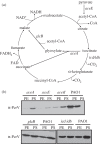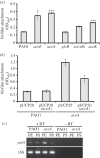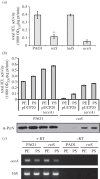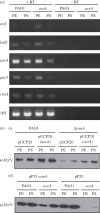Type III secretion system expression in oxygen-limited Pseudomonas aeruginosa cultures is stimulated by isocitrate lyase activity
- PMID: 23363478
- PMCID: PMC3603453
- DOI: 10.1098/rsob.120131
Type III secretion system expression in oxygen-limited Pseudomonas aeruginosa cultures is stimulated by isocitrate lyase activity
Abstract
Pseudomonas aeruginosa is an opportunistic human pathogen and a common cause of chronic infections in individuals with cystic fibrosis (CF). Oxygen limitation was recently reported to regulate the expression of a major virulence determinant in P. aeruginosa, the type III secretion system (T3SS). Here, we show that expression of the T3SS in oxygen-limited growth conditions is strongly dependent on the glyoxylate shunt enzyme, isocitrate lyase (ICL; encoded by aceA), which was previously shown to be highly expressed in CF isolates. ICL-dependent regulation of the T3SS did not alter the expression level of the master transcriptional regulator, ExsA, but did affect expression of the T3 structural proteins, effectors and regulators (ExsC, ExsD and ExsE). An aceA mutant displayed enhanced biofilm formation during anaerobic growth, which suggested that AceA-dependent modulation of type III secretion might impinge upon the RetS/LadS signalling pathways. Indeed, our data suggest that RetS is able to mediate some of its effects through AceA, as expression of aceA in trans partially restored T3SS expression in a retS mutant. Our findings indicate that AceA is a key player in the metabolic regulation of T3SS expression during oxygen-limited growth of P. aeruginosa. To the best of our knowledge, this is the first demonstration that the T3SS can be regulated by factors that do not affect ExsA expression levels.
Figures








Similar articles
-
Influence of RpoN on isocitrate lyase activity in Pseudomonas aeruginosa.Microbiology (Reading). 2010 Apr;156(Pt 4):1201-1210. doi: 10.1099/mic.0.033381-0. Epub 2010 Jan 21. Microbiology (Reading). 2010. PMID: 20093293
-
ExsD inhibits expression of the Pseudomonas aeruginosa type III secretion system by disrupting ExsA self-association and DNA binding activity.J Bacteriol. 2010 Mar;192(6):1479-86. doi: 10.1128/JB.01457-09. Epub 2009 Dec 11. J Bacteriol. 2010. PMID: 20008065 Free PMC article.
-
Isocitrate lyase supplies precursors for hydrogen cyanide production in a cystic fibrosis isolate of Pseudomonas aeruginosa.J Bacteriol. 2009 Oct;191(20):6335-9. doi: 10.1128/JB.00692-09. Epub 2009 Aug 21. J Bacteriol. 2009. PMID: 19700524 Free PMC article.
-
Fitting Pieces into the Puzzle of Pseudomonas aeruginosa Type III Secretion System Gene Expression.J Bacteriol. 2019 Jun 10;201(13):e00209-19. doi: 10.1128/JB.00209-19. Print 2019 Jul 1. J Bacteriol. 2019. PMID: 31010903 Free PMC article. Review.
-
Transcriptional regulation of the Pseudomonas aeruginosa type III secretion system.Mol Microbiol. 2006 Nov;62(3):631-40. doi: 10.1111/j.1365-2958.2006.05412.x. Epub 2006 Sep 21. Mol Microbiol. 2006. PMID: 16995895 Review.
Cited by
-
Role of Glyoxylate Shunt in Oxidative Stress Response.J Biol Chem. 2016 May 27;291(22):11928-38. doi: 10.1074/jbc.M115.708149. Epub 2016 Apr 1. J Biol Chem. 2016. PMID: 27036942 Free PMC article.
-
Metabolic specialization drives reduced pathogenicity in Pseudomonas aeruginosa isolates from cystic fibrosis patients.PLoS Biol. 2024 Aug 23;22(8):e3002781. doi: 10.1371/journal.pbio.3002781. eCollection 2024 Aug. PLoS Biol. 2024. PMID: 39178315 Free PMC article.
-
Global reprogramming of virulence and antibiotic resistance in Pseudomonas aeruginosa by a single nucleotide polymorphism in elongation factor, fusA1.J Biol Chem. 2020 Nov 27;295(48):16411-16426. doi: 10.1074/jbc.RA119.012102. Epub 2020 Sep 17. J Biol Chem. 2020. PMID: 32943550 Free PMC article.
-
It's Not Easy Being Green: A Narrative Review on the Microbiology, Virulence and Therapeutic Prospects of Multidrug-Resistant Pseudomonas aeruginosa.Antibiotics (Basel). 2021 Jan 4;10(1):42. doi: 10.3390/antibiotics10010042. Antibiotics (Basel). 2021. PMID: 33406652 Free PMC article. Review.
-
Battle royale: Immune response on biofilms - host-pathogen interactions.Curr Res Immunol. 2023 Mar 28;4:100057. doi: 10.1016/j.crimmu.2023.100057. eCollection 2023. Curr Res Immunol. 2023. PMID: 37025390 Free PMC article. Review.
References
-
- Yahr TL, Goranson J, Frank DW. 1996. Exoenzyme S of Pseudomonas aeruginosa is secreted by a type III pathway . Mol. Microbiol. 22, 991–100310.1046/j.1365-2958.1996.01554.x (doi:10.1046/j.1365-2958.1996.01554.x) - DOI - DOI - PubMed
-
- Yahr TL, Vallis AJ, Hancock MK, Barbieri JT, Frank DW. 1998. ExoY, an adenylate cyclase secreted by the Pseudomonas aeruginosa type III system. Proc. Natl Acad. Sci. USA 95, 13 899–13 90410.1073/pnas.95.23.13899 (doi:10.1073/pnas.95.23.13899) - DOI - DOI - PMC - PubMed
-
- Finck-Barbançon V, Goranson J, Zhu L, Sawa T, Wiener-Kronish JP, Fleiszig SM, Wu C, Mende-Mueller L, Frank DW. 1997. ExoU expression by Pseudomonas aeruginosa correlates with acute cytotoxicity and epithelial injury. Mol. Microbiol. 25, 547–55710.1046/j.1365-2958.1997.4891851.x (doi:10.1046/j.1365-2958.1997.4891851.x) - DOI - DOI - PubMed
Publication types
MeSH terms
Substances
Grants and funding
LinkOut - more resources
Full Text Sources
Other Literature Sources
Molecular Biology Databases

